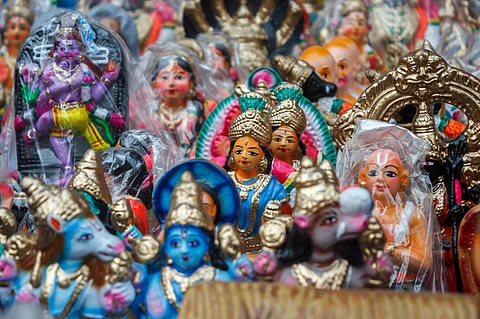
- Destinations
- Experiences
- Stay
- What's new
- Celebrating People
- Responsible Tourism
- CampaignsCampaigns
- SubscribeSubscribe
- Buy Now

Golu, also known as Kolu or Bommai Golu, is a traditional festival celebrated mainly in the South Indian states of Tamil Nadu, Karnataka, Andhra Pradesh, and Telangana. It is primarily observed during the celebration of Navaratri, which typically falls in September or October and continues for nine days. The word "Bommai Golu" in Tamil means 'Doll Decoration', while "Bommala Koluvu" in Telugu means 'Court of Toys' and "Gombe Habba" means 'Doll Festival' in Kannada. The festival is an important cultural event that brings people together and showcases creativity and artistry through doll displays.
Golu is a significant occasion for Hindus, celebrated during Navaratri, as it symbolises the victory of good over evil. During Navaratri, it is believed that the divine energy of Goddess Durga is at its peak, and the purpose of Golu is to invoke her blessings and celebrate her divine presence. The Golu arrangement typically includes an odd-numbered set of steps, usually three, five, seven, or nine tiers, decorated with various dolls and figurines. These dolls represent different themes, such as mythological stories, religious deities, historical events, and scenes from everyday life. They are made of clay, wood, or modern materials. The themes can range from depictions of the Ramayana and Mahabharata to village life and contemporary social issues.
While traditionally the theme of the Golu figure and figurines narrate the stories of the ancient epics, more recent renditions of the practice also tends to include contemporary social commentary.
Golu is a festival that promotes community participation and social cohesion. It offers an excellent opportunity for people to come together, exchange cultural ideas, and strengthen their interpersonal relationships. During the festival, women and children are particularly encouraged to visit various households to view the Golu displays, exchange gifts, and engage in cultural activities. This fosters a sense of unity and goodwill among the community members.
In addition to the Golu display, several cultural activities and performances are organised, including classical music and dance recitals, storytelling sessions, and devotional singing. These events showcase the region's rich artistic and cultural heritage and provide a platform for local artists to display their talents and skills.
During the nine-day festival, households perform special prayers and rituals and offer flowers, fruits, and sweets to the deities on the Golu display. Families prepare traditional dishes and sweets and share them with their loved ones and guests, signifying the spirit of sharing and unity. Golu is not just a religious event but also a celebration of art, culture, and community bonding. It represents the victory of good over evil, the importance of knowledge and wisdom, and the celebration of diversity and interconnectedness. The festival helps people uphold traditional values and pass them down to future generations, ensuring the preservation of their cultural identity. Ranjani Subramanian, a Tamilian living in Mumbai puts up decorations of her Golu dolls every Navaratri. "Traditionally, the custom passed down from Mother-in-law's to their daughter-in-law's and that is how I started too", she says. "A decade ago I only followed the ritual of keeping the Golu dolls on display but over the years, the creativity it involves has made me more enthusiastic", she explained. In 2024, she has added a park to her collection based on her idea of a Thai Buddhist park.
The Golu festival concludes with the celebration of Vijaya Dashami, considered one of the most auspicious days. It is believed that on this day, the demon Mahishasura was defeated by the goddess Durga, signifying the triumph of good over evil. In the evening, one of the dolls from the Golu display is symbolically put to sleep, and the Kalasha is slightly moved towards the North, indicating the end of that year's Navaratri Golu display. Prayers are offered to express gratitude to the deities for the successful completion of the festival, with hopes for a prosperous and successful year ahead. After this, the Golu steps are carefully dismantled, and the dolls and figurines are packed up, ready to be stored for the following year's celebration. This ceremonial conclusion encapsulates the spirit of the festival, emphasising the cycle of renewal, positivity, and the continuity of tradition.
